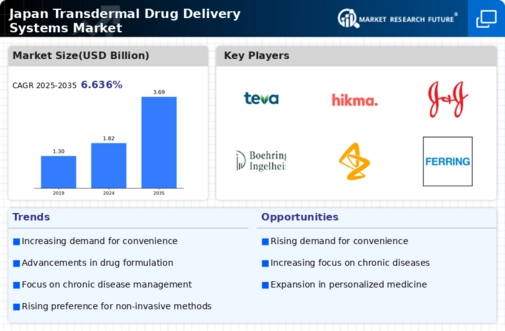Growing Awareness and Education
Growing awareness and education regarding the benefits of transdermal drug delivery are driving the market in Japan. Healthcare professionals and patients are increasingly informed about the advantages of transdermal systems, such as improved patient compliance and reduced side effects. Educational initiatives by pharmaceutical companies and healthcare organizations are playing a crucial role in disseminating information about the efficacy and safety of transdermal therapies. This heightened awareness is likely to lead to increased adoption of transdermal systems, particularly among patients with chronic conditions who require consistent medication. Market analysts project that as awareness continues to rise, the transdermal drug-delivery-systems market could see a growth rate of approximately 6% over the next few years. Consequently, the emphasis on education and awareness is expected to significantly impact the market dynamics in Japan.
Innovations in Drug Formulation
Innovative drug formulations are playing a pivotal role in shaping the transdermal drug-delivery-systems market in Japan. Advances in polymer technology and drug encapsulation techniques have led to the development of more effective transdermal patches that can deliver a wider range of therapeutic agents. For instance, the introduction of microneedle technology allows for enhanced skin permeability, enabling the delivery of larger molecules that were previously unsuitable for transdermal administration. This innovation is expected to increase the market's value, with estimates suggesting a potential growth to $1 billion by 2027. Additionally, the ability to customize drug release profiles enhances the therapeutic efficacy of treatments, making transdermal systems more appealing to both patients and healthcare providers. Consequently, the transdermal drug-delivery-systems market is likely to benefit from these advancements, fostering a competitive landscape in Japan.
Supportive Regulatory Environment
A supportive regulatory environment is fostering growth in the transdermal drug-delivery-systems market in Japan. The Pharmaceuticals and Medical Devices Agency (PMDA) has streamlined approval processes for innovative drug delivery systems, encouraging manufacturers to invest in research and development. This regulatory support is crucial for bringing new transdermal products to market, as it reduces the time and cost associated with product development. Furthermore, the PMDA's emphasis on safety and efficacy ensures that only high-quality products reach consumers, thereby enhancing public trust in transdermal therapies. As a result, the market is expected to expand, with an anticipated increase in the number of approved transdermal products. This favorable regulatory landscape is likely to attract both domestic and international players to the transdermal drug-delivery-systems market, contributing to its overall growth in Japan.
Rising Demand for Non-Invasive Therapies
The transdermal drug-delivery-systems market in Japan is experiencing a notable increase in demand for non-invasive therapeutic options. Patients and healthcare providers are increasingly favoring transdermal systems due to their ease of use and reduced discomfort compared to traditional injection methods. This shift is particularly evident in the management of chronic conditions such as diabetes and hypertension, where patients prefer patches over needles. The market is projected to grow at a CAGR of approximately 8% over the next five years, driven by this preference for non-invasive solutions. Furthermore, the convenience of self-administration enhances patient compliance, which is crucial for effective treatment outcomes. As a result, the transdermal drug-delivery-systems market is likely to expand significantly, catering to the evolving needs of the Japanese population seeking effective and user-friendly medication delivery methods.
Increased Focus on Chronic Disease Management
The transdermal drug-delivery-systems market in Japan is significantly influenced by the rising prevalence of chronic diseases. Conditions such as diabetes, cardiovascular diseases, and chronic pain are becoming more common, necessitating effective management strategies. Transdermal systems offer a viable solution for continuous drug delivery, which is essential for maintaining stable therapeutic levels in patients with chronic conditions. The market is projected to witness a growth rate of around 7% annually as healthcare providers increasingly adopt these systems for long-term treatment plans. Moreover, the convenience of transdermal patches aligns with the growing trend of personalized medicine, where treatment regimens are tailored to individual patient needs. This focus on chronic disease management is likely to propel the transdermal drug-delivery-systems market forward, addressing the healthcare challenges faced by the aging population in Japan.























Leave a Comment